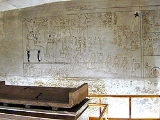
KV57
Encyclopedia
Tomb KV57, located in the Valley of the Kings
in Egypt
, was used for the burial of Horemheb
, the last Pharaoh
of the Eighteenth dynasty
.
The tomb was located by Edward Ayrton
in February 1908, who was working for Theodore Davis. Due to its location in the valley floor, the tomb was filled with debris that had been washed down in the occasional flash-flooding.
The tomb is markedly different from the other major Eighteenth dynasty royal tombs. It does away with the dog-legged construction, and has painted bas-reliefs, rather than simple painted walls. Passages from the Book of Gates
appear for the first time. The decoration was not completed, even though the king ruled for twenty-eight years.
The sarcophagus
of the king was constructed from carved, red quartzite
, and was found with its lid broken. In it were contained bones and remains from several burials, none of them conclusively from Horemheb.
Valley of the Kings
The Valley of the Kings , less often called the Valley of the Gates of the Kings , is a valley in Egypt where, for a period of nearly 500 years from the 16th to 11th century BC, tombs were constructed for the Pharaohs and powerful nobles of the New Kingdom .The valley stands on the west bank of...
in Egypt
Egypt
Egypt , officially the Arab Republic of Egypt, Arabic: , is a country mainly in North Africa, with the Sinai Peninsula forming a land bridge in Southwest Asia. Egypt is thus a transcontinental country, and a major power in Africa, the Mediterranean Basin, the Middle East and the Muslim world...
, was used for the burial of Horemheb
Horemheb
Horemheb was the last Pharaoh of the 18th Dynasty from either 1319 BC to late 1292 BC, or 1306 to late 1292 BC although he was not related to the preceding royal family and is believed to have been of common birth.Before he became pharaoh, Horemheb was the commander in chief...
, the last Pharaoh
Pharaoh
Pharaoh is a title used in many modern discussions of the ancient Egyptian rulers of all periods. The title originates in the term "pr-aa" which means "great house" and describes the royal palace...
of the Eighteenth dynasty
Eighteenth dynasty of Egypt
The eighteenth dynasty of ancient Egypt is perhaps the best known of all the dynasties of ancient Egypt...
.
The tomb was located by Edward Ayrton
Edward R. Ayrton
Edward Russell Ayrton was an English Egyptologist and archaeologist.He was the son of William Scrope Ayrton and his wife Ellen Louisa McClatchie, and was born in Wuhu, China, on 17 December 1882...
in February 1908, who was working for Theodore Davis. Due to its location in the valley floor, the tomb was filled with debris that had been washed down in the occasional flash-flooding.
The tomb is markedly different from the other major Eighteenth dynasty royal tombs. It does away with the dog-legged construction, and has painted bas-reliefs, rather than simple painted walls. Passages from the Book of Gates
Book of Gates
The Book of Gates is an Ancient Egyptian funerary text dating from the New Kingdom. It narrates the passage of a newly deceased soul into the next world, corresponding to the journey of the sun though the underworld during the hours of the night. The soul is required to pass though a series of...
appear for the first time. The decoration was not completed, even though the king ruled for twenty-eight years.
The sarcophagus
Sarcophagus
A sarcophagus is a funeral receptacle for a corpse, most commonly carved or cut from stone. The word "sarcophagus" comes from the Greek σαρξ sarx meaning "flesh", and φαγειν phagein meaning "to eat", hence sarkophagus means "flesh-eating"; from the phrase lithos sarkophagos...
of the king was constructed from carved, red quartzite
Quartzite
Quartzite is a hard metamorphic rock which was originally sandstone. Sandstone is converted into quartzite through heating and pressure usually related to tectonic compression within orogenic belts. Pure quartzite is usually white to gray, though quartzites often occur in various shades of pink...
, and was found with its lid broken. In it were contained bones and remains from several burials, none of them conclusively from Horemheb.
External links
- Theban Mapping Project: KV57 - Includes detailed maps of the tomb.

